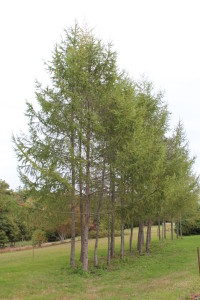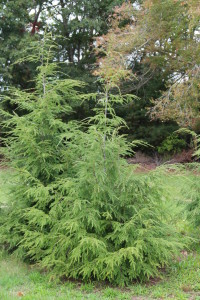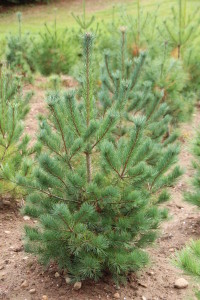Prices
$50-70 for 4-10 ft trees
Dig your own, or we dig for you.
Thuja occidentalis
(American Arborvitae, other common names; eastern white cedar, northern white cedar)
Height to 60'. Zone 3. Native to eastern U.S. and Canada. Arborvitae means "tree of life." Narrow and tall with twiggy branches, soft fibrous orange-brown bark, and flat foliage is unlike that of any other conifer. Valuable light, fragrant wood is the standard for fence posts. Slow growing, lives up to 400 years. Thrives in rich, moist and marshy neutral-to-alkaline soils. Makes an elegant, narrow hedge either sheared or left to its natural pyramidal shape. Wildlife Value, Windbreak Recommended, Native.
Picea glauca
(White Spruce)
To 75'. Zone 3. Silver-green foliage on pendulous branches. Tolerant of wind and wet soils. Native to the northern U.S. and Canada. Wildlife Value, Windbreak Recommended, Native.
Picea pungens glauca
(Colorado Blue Spruce)
To 100'. Zone 2. Bluish green foliage. Preferred species of spruce for most ornamental situations. Popular specimen tree with truer blue foliage than other varieties. Can be used as a screen, as it is fast growing after 3'. Does not like wet soil. Extra spring nitrogen will improve blue color, which doesn't appear for the first few years. Native to western U.S. Widely planted across the country. Wildlife Value, Windbreak Recommended.
Larix leptolepis
(Japanese Larch)
To 90'. Zone 4 Highly ornamental with red-brown exfoliating bark. Golden-yellow fall foliage color. Frequent bonsai species. Medium to fast growth.

Tsuga canadensis
(Eastern Hemlock)
To 75; Zone 5. Large, pyramid shaped tree, normally multi-trunk. Graceful, pendulous branchlets. Makes a wonderful sheared hedge in dense plantings.
Windbreak Recommended, Native.

Pinus strobus
(Eastern White Pine)
To 150'. Zone 4. Native five needle pine with a variety of uses; Christmas trees, windbreaks, wildlife habitat, or as an ornamental. Fast growing. Adaptable. Transplants easily in a wide range of soils. The largest northeastern conifer. Magnificent and massive when mature. Smooth greyish-green bark becomes thick, rough and deeply furrowed with age. When grown in abandoned fields, it develops huge curving branches. Grown in the forest it will typically be "clear" for the first 30-80'. Planted thick and sheared, it makes a beautiful hedge that won't drop its lower branches. Likes ordinary to poor - even sandy- soil. Shade tolerant, but does not like salt or roadsides. Native eastern U.S. Drought Resistant, Wildlife Value, Windbreak Recommended.

Pinus strobiformis
(Southwestern White Pine)
To 75'. Zone 5. Ornamental five needle pine known for soft bluish green needles. Heat and drought tolerant. Wildlife Value, Native southwest US into Mexico. An excellent option to the traditional Eastern White Pine in drought prone soils.

Metasequoia gluptostroboides
(Dawn Redwood)
To 100', Zone 4. Ancient deciduous conifer from China that looks somewhat like our own Coast Redwood but with much smaller cones and soft bright green leaves. Reddish fall color. Very fast growing when young. Known as the "Dinosaur Tree" because the species was around over 20 million years ago and considered extinct until a few trees were found in China in the 1940's. One of the most spectacular of the ornamental trees. Grows quickly, up to 50' in 15-20 years, with many small-diameter horizontal branches and a uniform conical shape. Give it lots of space to grow! Highly adaptable, easy to transplant. Prefers moist deep well-drained slightly acid soil in full sun. Will tolerate wet or dry sites. Pollution resistant; good specimen or street tree, rarely needs pruning. Native to China and Japan.
